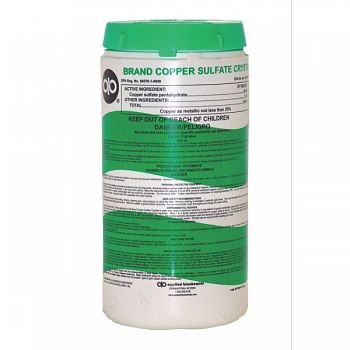
Copper Sulfate for Pond Algae Control

Used to control green and blue-green algae, diatoms and flagellates and certain weeds found in ponds, lakes, ditches and irrigation systems. Active Ingredients by weight: 99.0% Copper Sulfate Pentahydrate 1.0% other ingredients
Copper Sulfate for Pond Algae Control has different options and/or variations, please choose below.

Copper Sulfate for Pond Algae Control
Enter the quantity below and click "add to cart":
Category(s):
- Herbicides and Algaecides
Manufacturer: APPLIED BIO CHEMISTS
This product cannot ship to CT, DC, MA, ME, NJ, NY, VT due to state restrictions.
Used to control green and blue-green algae, diatoms and flagellates and certain weeds found in ponds, lakes, ditches and irrigation systems. Active Ingredients by weight: 99% Copper Sulfate Pentahydrate 1.0% other ingredients.
GENERAL INSTRUCTIONS FOR USE
Water hardness, temperature of the water, the type and amount of vegetation to be controlled, and the amount of water flow are to be considered in using this product to control algae. Begin treatment soon after plant growth has started. If treatment is delayed until a large amount of algae is present, larger quantities of this product will be required. Algal growth is difficult to control with this product when water temperatures are low or when the water conditions are hard water. Larger quantities of this product will be required to kill and control algae in water that is flowing than in a body of stagnant water. If possible, curtail the flow of water before treatment and hold dormant for approximately three days after treatment or until the algae have begun to die. When preparing a solution of this product in water, the mixing container should be made of plastic or glass: or, a painted, enameled, or copper lined metal container. It is usually best to treat algae on a sunny day when the heavy mats of filamentous algae are most likely to be floating on the surface where it can be sprayed directly. If there is some doubt about the concentration to apply, it is generally best to start with a lower concentration and to increase this concentration until the algae are killed.
Treatment of algae can result in oxygen loss from decomposition of dead algae. This loss can cause fish suffocation. Therefore, to minimize this hazard, treat one-third to one-half of the water area in a single operation and wait 10 to 14 days in between treatments. Begin treatments along the shore and proceed outward in bands to allow fish to move into untreated water. NOTE: If treated water is to be used as a source of potable water, the metallic copper residual must not exceed 1 ppm (4 ppm copper sulfate pentahydrate).
CALCULATIONS FOR THE AMOUNT OF WATER IMPOUNDED AND FOR THE AMOUNT OF AB BRAND COPPER SULFATE CRYSTALS TO BE USED: Calculate water volume as follows: (1) Obtain surface area by measuring of regular shaped ponds or mapping of irregular ponds or by reference to previously recorded engineering data or maps. (2) Calculate average depth by sounding in a regular pattern and taking the mean of these readings or by reference to previously obtained data. (3) Multiply surface area in feet by average depth in feet to obtain cubic feet of water volume. (4) Multiply surface area in acres by average depth in feet to obtain total acre-feet of water volume.
CALCULATE WEIGHT OF WATER TO BE TREATED AS FOLLOWS: (1) Multiply volume in cubic feet by 62.44 to obtain total pounds of water, or (2) Multiply volume in acre feet by 2,720,000 to obtain pounds of water.
CALCULATIONS OF ACTIVE INGREDIENT TO BE ADDED: To calculate the amount of Copper Sulfate Pentahydrate needed to achieve the recommended concentration, multiply the weight of water by the recommended concentration of AB Brand Copper Sulfate Crystals. Since recommended concentrations are normally given in parts per million (ppm), it will first be necessary to convert the value in parts per million to a decimal equivalent. For example, 2 ppm is the same as 0.000002 when used in this calculation. Therefore, to calculate the amount of Copper Sulfate Pentahydrate to treat 1 acre-foot of water with 2 ppm AB Brand Copper Sulfate Crystals, the calculation would be as follows: 0.000002 X 2,720,000 = 5.44 lbs. Copper Sulfate Pentahydrate
CALCULATION OF WATER FLOW IN DITCHES, STREAMS, AND IRRIGATION SYSTEMS: The amount of water flow in cubic feet per second is found by means of a weir or other measuring device.
SPECIFIC INSTRUCTIONSTO CONTROL ALGAE IN IMPOUNDED WATERS, LAKES, PONDS AND RESERVOIRS: There are several methods by which to apply this product to impounded water. Probably the most satisfactory and simplest method is to dissolve this product in water and to spray this water over the body of water from a boat. A small pump mounted in the boat can easily be used for this purpose. Fine crystals may be broadcasted directly on the water surface from a properly equipped boat. A specially equipped air blower can be used to discharge fine crystals at a specific rate over the surface of the water. When using this method, the direction of the wind is an important factor. Do not use this method unless completely familiar with this type of application. Where the situation permits, this product may be applied under the water by dragging burlap bags containing this product. The crystals are placed in burlap bags and dragged through the water by means of a boat. Begin treatment along the shoreline and proceed outward until one-third to one-half of the total area has been treated. Care should be taken that the course of the boat is such as to cause even distribution of the chemical. In large lakes, it is customary for the boat to travel in parallel lines about 20 to 100 feet apart. Continue dragging the burlap bags over the treated area until the minimum dosage is achieved and all crystals have been dissolved. Large or medium size crystals that dissolve slowly should be used with this method. This product can be applied to impounded waters by injecting a solution of this product in water via a piping system.
AB BRAND COPPER SULFATE CRYSTALS REQUIRED FOR TREATMENT OF DIFFERENT GENERA OF ALGAE The genera of algae listed below are commonly found in waters of the United States. Use the lower recommended rate in soft waters (less than 50 ppm methyl orange alkalinity) and the higher concentration in hard waters (above 50 ppm alkalinity). Always consult State Fish and Game Agency before applying this product to municipal waters.
Typical applications use:* ¼ - ½ ppm = .67 – 1.3 lbs/acre ft. * 1 -1½ ppm = 2.6 – 3.9 lbs/acre ft.
* ½ - 1 ppm = 1.3 – 2.6 lbs/acre ft. * 1½ - 2 ppm = 3.9 – 5.32 lbs/acre ft.
Added or Last Modified: 5/7/2013
Copper Sulfate - Size (15 lbs) Model: 390835
Instantly and effectively kills most forms of algae including swimmers itchEasy to apply and economical
Treats about 10,000 square feet of filamentous algae (moss)
Made in the usa25% Copper Compound In Fine Crystal Form.
UPC: 038005908250
15 lb.
Copper Sulfate - Size (5 lbs.) Model: 390840
Instantly and effectively kills most forms of algae including swimmers itchEasy to apply and economical
Treats about 10,000 square feet of filamentous algae (moss)
Made in the usa25% Copper Compound In Fine Crystal Form.
UPC: 768980003335
5 lb.
Continental US shipping costs start at: 7.99 (We do not charge handling).
Cart total >$100 qualifies for free shipping. *Weight restrictions may apply.
We will process your order the day we receive it.
This product usually leaves our warehouse the NEXT BUSINESS DAY.
You will normally get your order in 3 - 7 business days (depending on how far you are from the warehouse).
Shipping rates are calculated based on:
- Total weight of the products in your cart. Individual item shipping carrier fee ( if applicable ).

Comments, Reviews and Ratings

Very happy with purchase, I live in Rhode Island and this showed up on my doorstep the day after I ordered! I didn't even pay for expedited shipping. Fast, great service.Tony, Wed Aug 01, 2012

There are several methods by which to apply this product to impounded water. Probably the most satisfactory and simplest method is to dissolve this product in water and to spray this water over the body of water from a boat. Tom, Fri Jul 27, 2012
People who viewed this also viewed:
More options:
Copyright 1999-2024 GregRobert Enterprises, LLC.
Family Owned / Family Values



